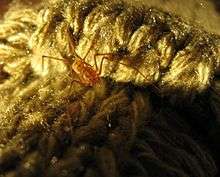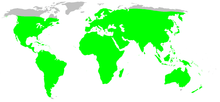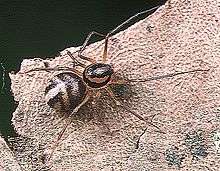Spitting spider
Spitting spiders (Scytodidae) is a family of araneomorph spiders first described by John Blackwall in 1864.[1] It contains over 250 species in five genera,[2] of which Scytodes is the best-known.
| Spitting spiders | |
|---|---|
.jpg) | |
| Scytodes thoracica | |
 | |
| Scytodes male, showing pedipalps | |
| Scientific classification | |
| Kingdom: | Animalia |
| Phylum: | Arthropoda |
| Subphylum: | Chelicerata |
| Class: | Arachnida |
| Order: | Araneae |
| Infraorder: | Araneomorphae |
| Family: | Scytodidae Blackwall, 1864 |
| Diversity | |
| 5 genera, 277 species | |
 | |
Description
Like recluse spiders and coneweb spiders, they have six eyes arranged in three pairs and are haplogyne, meaning they have less complex female genitalia. They differ from these families in having a dome-shaped carapace and in their characteristic flecked pattern of spots.
Hunting technique
Scytodidae catch their prey by spitting a fluid that congeals on contact into a venomous and sticky mass. The fluid contains both venom and spider silk in liquid form, though it is produced in venom glands in the chelicerae. The venom-laced silk both immobilizes and envenoms prey such as silverfish. In high-speed footage the spiders can be observed swaying from side to side as they "spit", catching the prey in a crisscrossed "Z" pattern; it is criss-crossed because each of the chelicerae emits half of the pattern. The spider usually strikes from a distance of 10 to 20 millimetres (0.39 to 0.79 in) and the entire attack sequence only lasts 1/700th of a second.[3] After making the capture, the spider typically bites the prey with venomous effect, and wraps it in the normal spider fashion with silk from the spinnerets.[4]
Presocial behaviour
Some species exhibit presocial behaviour, in which mature spiders live together and assist the young with food.[5]
Genera

As of April 2019, the World Spider Catalog accepts the following genera:[2]
See also
References
- Blackwall, J. (1864). A history of the spiders of Great Britain and Ireland. Ray Society, London. pp. 175–384.
- "Family: Scytodidae Blackwall, 1864". World Spider Catalog. Natural History Museum Bern. Retrieved 2019-04-24.
- Piper, Ross (2007). Extraordinary Animals: An Encyclopedia of Curious and Unusual Animals. Westport, Conn.: Greenwood Press. ISBN 978-0-313-33922-6.
- Gilbert, C.; Rayor, L.S. (1985). "Predatory behavior of spitting spiders (Araneae, Scytodidae) and the evolution of prey wrapping". Journal of Arachnology. 13 (2): 231–241. JSTOR 3705028.
- Miller, Jeremy (2010). "Taxon page for Scytodes socialis Miller, 2006". Archived from the original on 2012-03-31.
External links
- Arachnology Home Pages: Araneae
- Info about Spitting spider Scytodes thoracica
- Platnick, N.I. 2003. World Spider Catalog
| Wikispecies has information related to Scytodidae |
| Wikimedia Commons has media related to Scytodidae. |